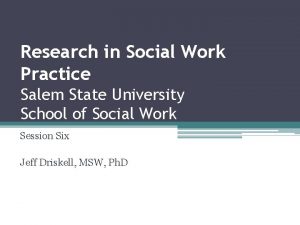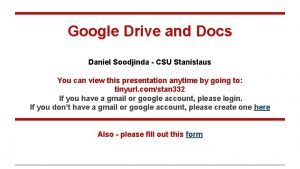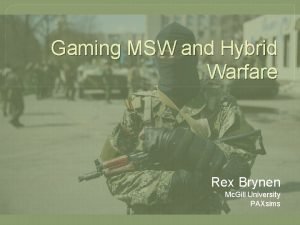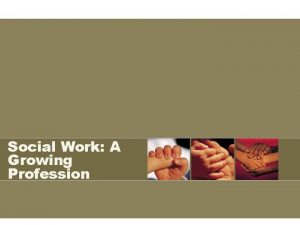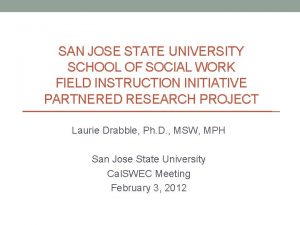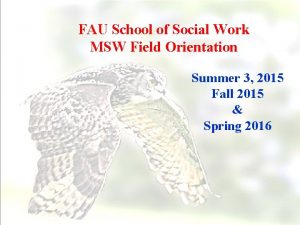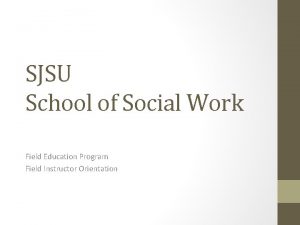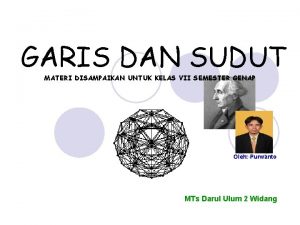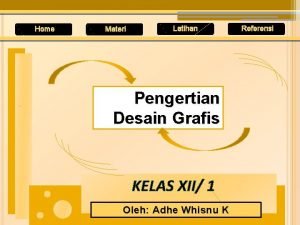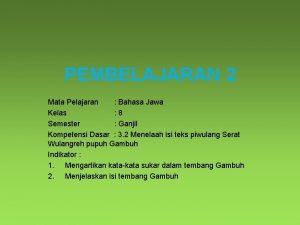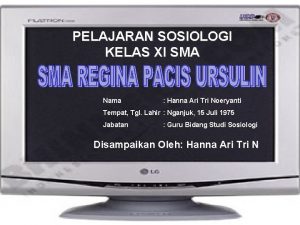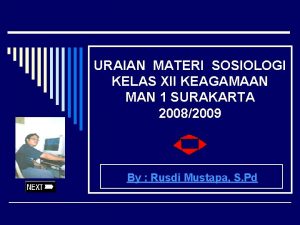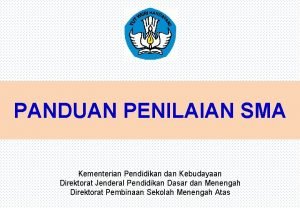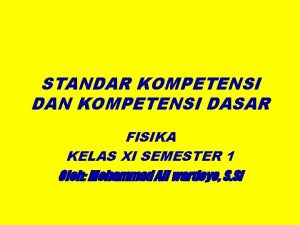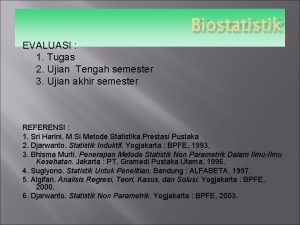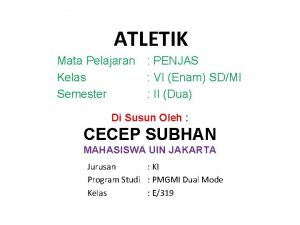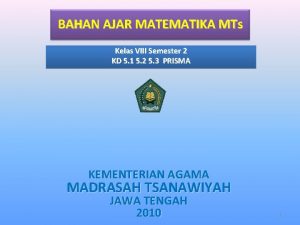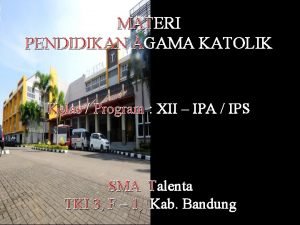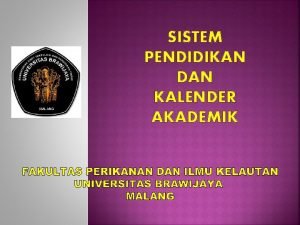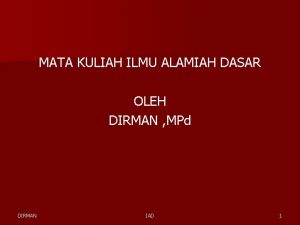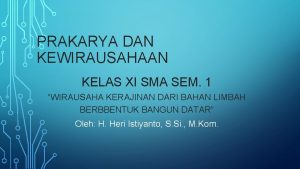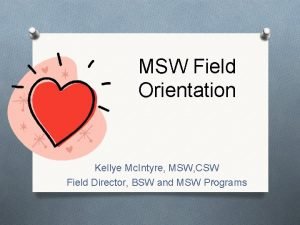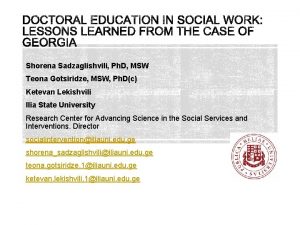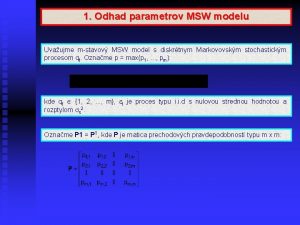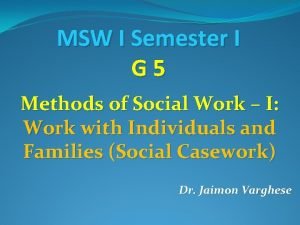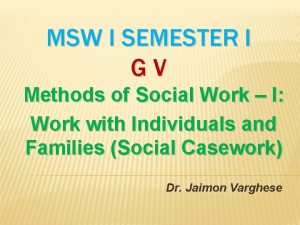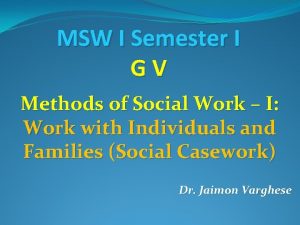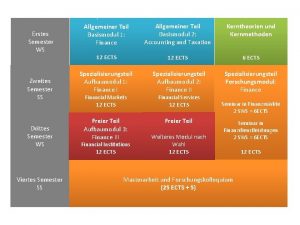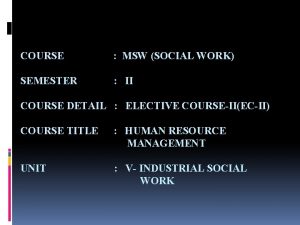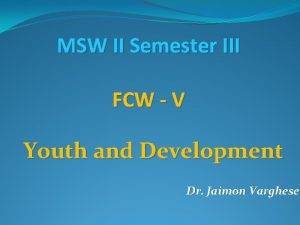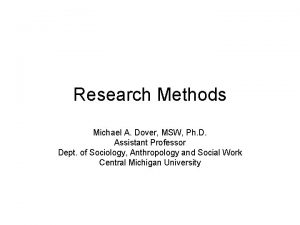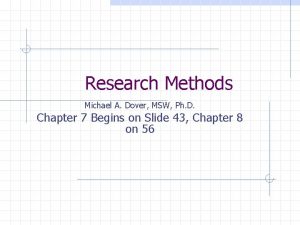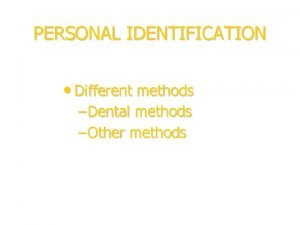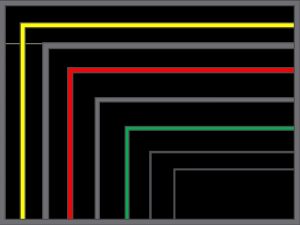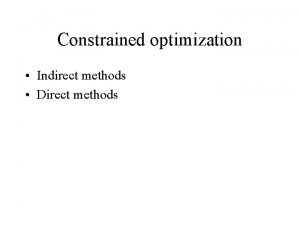MSW I Semester I G II Methods of







































































- Slides: 71

MSW I Semester I G II Methods of Social Work – I: Work with Individuals and Families (Social Casework) Dr. Jaimon Varghese

Unit 4 Tools of Working with Individuals and Families i. Intake-record/sheet and the intake interview (client engagement) ii. Casework interview iii. Home visit iv. Case worker –client relationship 10 -09 -2021 13: 44: 12 Method 1: Social Casework 2

Unit 4 Tools of Working with Individuals and Families v. Knowledge of resources (networking) vi. Communication - verbal, nonverbal, eye contact, body language. vii. Recording and its types – narrative, process, summary 10 -09 -2021 13: 44: 13 Method 1: Social Casework 3

Tools of Social case work Intake Recording skills Casework interview Social Case Work Home Visits Communicat ion Networking Clientworker relationship

4. i. Intake-record/sheet and the intake interview (client engagement) Intake record (semi structured interview) • Personal information • Family information • Educational background • Occupational history • Economic condition • Cultural background • Case history (origin and development of the problem) 10 -09 -2021 13: 44: 15 Method 1: Social Casework 5

4. i. Intake-record/sheet and the intake interview (client engagement) • Every social work agency stores printed proforma that is called the 'intake sheet'. • These areas generally include the client's address, demographic data, reasons for referral, family background and the like. • Besides these, the social worker records many other things as the case progresses. His/her work diary is meant for jottings on events as they happen. 10 -09 -2021 13: 44: 16 Method 1: Social Casework 6

4. i. Intake-record/sheet and the intake interview (client engagement) • The jottings cover names, addresses, dates, notes on interviews, points of importance gleaned from conversations with people other than clients — collaterals and resource persons, observations, inferences and elements of the casework process. 10 -09 -2021 13: 44: 17 Method 1: Social Casework 7

4. i. Intake-record/sheet and the intake interview (client engagement) • From the data which are in a jumble in the work diary, the social worker organises systematically the content of the formal case record, which is a formal or official record maintained at the agency. 10 -09 -2021 13: 44: 17 Method 1: Social Casework 8

4. i. Intake-record/sheet and the intake interview (client engagement) • Collaterals are those, who, because of their special association with the client, are in a position to furnish information to the social worker about the client or help the client in some way. • The doctor who is treating the client, and the teacher of the school-going client, are some examples of collaterals. 10 -09 -2021 13: 44: 17 Method 1: Social Casework 9

4. i. Intake-record/sheet and the intake interview (client engagement) • Resource persons are those who, on account of their special position in the community, are able to help the client by means of material or nonmaterial resources. • Intake interview intends to engage the client on an agreed contract of timings, fees, etc. 10 -09 -2021 13: 44: 19 Method 1: Social Casework 10

4. i. Intake-record/sheet and the intake interview (client engagement) • The intent of the casework process is to engage the person himself both in working on and in coping with the one or several problems that confront him and to do so, by such means as may stand him in good stead as he goes forward in living. • The means are (i) the provision of a therapeutic relationship that sustains the client and affects the nature of his emotional relation to his problems; 10 -09 -2021 13: 44: 19 Method 1: Social Casework 11

4. i. Intake-record/sheet and the intake interview (client engagement) • (ii) the provisions of a systematic though, always flexible way by which the client may discuss and work over the nature of his problems, his relation to it and its potential solutions; and • (iii) the provision of such opportunities and aids (those of communications and / or of resources) as will further exercise and implement the client’s adaptive action upon this problems (Perlman, 1957: 58) 10 -09 -2021 13: 44: 20 Method 1: Social Casework 12

4. ii. Casework interview • Semi structured, structured and unstructured • Stage 1: fact finding interview (intake) • Stage 2: diagnostic (includes collateral interview) • Stage 3: treatment (case work intervention): • Non directive, person centred, humanist, in depth interview • Goal setting • Performance watch & monitoring • Stage 4: follow up interview • Stage 5: withdrawal / termination interview 10 -09 -2021 13: 44: 21 Method 1: Social Casework 13

4. ii. Casework interview • objectives of the first interview: • (1) To give the client a fair and patient hearing • (2) To establish, if possible, a sympathetic mutual understanding – a good basis, that is, for further intercourse • (3) To secure clues to whatever other sources of information will give a deeper insight into the difficulties of his situation and their possible solutions 10 -09 -2021 13: 44: 22 Method 1: Social Casework 14

4. ii. Casework interview • objectives of the first interview: • (4) To begin even at this early stage, the slow process of developing self-help and self reliance, though only by the tonic influence which an understanding spirit always exerts, and with the realisation that later the client’s own level of endeavour will have to be sought, found and respected. 10 -09 -2021 13: 44: 22 Method 1: Social Casework 15

4. ii. Casework interview • The client’s own hopes, plans, and attitudes towards life are more important than any single item of information. • We must break through the narrow circle of our client’s own view and get into the wider one of those who know and understand him. • We must defend upon the first interview for those clues which are most likely to supplement and round out his story (Mary Richmond, 1917: 113 -133) 10 -09 -2021 13: 44: 23 Method 1: Social Casework 16

4. ii. Casework interview • The casework interview refers to the meeting of the social worker and the client in a face-to-face conversation. It is not a casual conversation but a professional activity on the part of the social worker, because the conversation is geared to specific or general purposes. The purposes may be one or more of the following: • (1) to obtain information from, or impart information to, the client • (2) for studying and assessing the client's problem and related situation and • (3) to give help. 10 -09 -2021 13: 44: 23 Method 1: Social Casework 17

4. ii. Casework interview • The social worker has to gather data regarding the problem, how the client perceives it, what (s)he has done about it, some data about the client himself/herself, his/her family and his/her resources. When a client is not able to furnish the required information, members of his/her family are interviewed for the purpose. • Interviewing is a two-way process. Just as information is received by the social worker, so also information is imparted to the client regarding official procedures and other matters about himself/herself, his/her role as a social worker, and about the function of the agency. 10 -09 -2021 13: 44: 24 Method 1: Social Casework 18

4. ii. Casework interview • Information about the self is all the more important for those clients who come to the social worker not of their own volition but through other people's coercion. • Data gathered from and about the client are sorted out and analysed, from which relevant aspects are linked to form a verbal picture of the problem situation with clear indications of cause-effect relationships. • Ordinarily, a few interviews are necessary before an assessment of the situation can be made. 10 -09 -2021 13: 44: 24 Method 1: Social Casework 19

4. ii. Casework interview • Social assessment is also tentative and is bound to change depending upon the new social data that emerge as time goes on. Furthermore, there is no stipulation that social assessment should end before the helping process begins. • There are types of help that can be and should be rendered early enough — so much so that the action of providing help and efforts at formulating a social assessment occur side by side, at the same time. 10 -09 -2021 13: 44: 24 Method 1: Social Casework 20

4. ii. Casework interview • Interviewing serves as an indirect tool of help. The information that the social worker elicits and the social assessment that (s)he evolves serve as a blue print, based on which (s)he decides suitable modes of help. • The interview can be used as a direct medium of help as well. It is during the interview that many of the casework techniques are used. Similarly the principles also come into play in the interview. • Casework clients can be broadly divided into long term and short term cases, the latter group including even such cases as require only one contact and only one interview. 10 -09 -2021 13: 44: 25 Method 1: Social Casework 21

4. ii. Casework interview • Casework interview is operative as long as the individual is a client of the agency. • The case records covers periods ranging from two months to seven months, with the contacts with each client taking place once or twice a week. • In emergencies, clients were met more frequently. The interview is a channel of direct help even at the first contact between the social worker and the client. • The cordial way the client is received at the agency and made to feel accepted is itself a form of help and it encourages the client to continue with the agency in order that (s)he may receive other kinds of help. 10 -09 -2021 13: 44: 25 Method 1: Social Casework 22

4. ii. Casework interview • Those clients who do not seek help on their own, some of whom do not even acknowledge having problems are, however, compelled to come to the social worker by those exerting authority over them. • They come to the social worker with a built-in dislike for the latter and for such clients the first contact is crucial. It can be effectively used by the social worker for dispelling the client's pre-conceived notion and prejudices and for getting him/her favourably disposed to social work help. • Interviewing as a professional activity requires that the social worker prepares himself/herself for the occasion. 10 -09 -2021 13: 44: 26 Method 1: Social Casework 23

4. ii. Casework interview • After reviewing the previous interview or interviews with the same client, the social worker should make note of the gaps in information, the ambiguities that need clarification, and one's own lapses and shortcomings that need to be replaced with skills of handling. • Keeping these points of review in mind, the next interview should be planned for eliciting fresh data, clearing doubts, testing assumptions, assessing facts and for using techniques appropriately (Grace Mathew, 1992). 10 -09 -2021 13: 44: 27 Method 1: Social Casework 24

4. iii. Home visit- collateral contacts • Conducting the interviews in the office of the agency has certain advantages. It provides for privacy and prevents distractions. It invests a certain degree of formality and professionalism in the conversation, to the extent that the clients are encouraged to view the interviews seriously. • To some clients, the formality of the office may be threatening, provoking them to put on masks that hide their real selves and feelings. For such people, having one or two interviews at home will be a welcome relief (Grace Mathew, 1992). 10 -09 -2021 13: 44: 27 Method 1: Social Casework 25

4. iii. Home visit- collateral contacts • There also some other considerations which make home visits an important and necessary casework tool, First of all, there is the likelihood that the client perceives the social worker's visit to his/her home as an indication of the social worker's interest in his/her welfare. A recognition by the client of the social worker's interest and concern is desirable as far as the progress of the casework process is concerned. • Furthermore, there are clients whose fatalistic attitude to life's problems and the resultant resignation to problems prevents them from doing anything. 10 -09 -2021 13: 44: 28 Method 1: Social Casework 26

4. iii. Home visit- collateral contacts • Social workers have to go to them rather than wait for them at the agency. One, or two home visits may not bear any fruit; more visits will be necessary. • Home visit enables the social worker to observe the home environment of the client. • Importantly, the interactions which take place among the family members lend themselves to the social worker's observation from which the social worker is able to make useful inferences about the attitudes and relationships within the family. • The contradictions in parental handling could be easily seen by the social worker during home visits. 10 -09 -2021 13: 44: 28 Method 1: Social Casework 27

4. iv. Case worker-client relationship • Vital relationships between people rise out of shared and emotionally charged situations. • All growth producing relationships, of which the casework relationship is one, contains elements of acceptance and expectation, support and stimulation. • The identifying mark of a professional relationship is its conscious purposiveness growing out of the knowledge of what must go into achieving the goal. 10 -09 -2021 13: 44: 29 Method 1: Social Casework 28

4. iv. Case worker-client relationship • The case work relationship begins as the client shares some part of his problem and as the caseworker demonstrates that he feels with the client at the same time that he has professional competence to bring to dealing with the problem. • The case work relationship may have several therapeutic values. Relationship needs and difficulties from outside the casework relationship may have to be dealt with. 10 -09 -2021 13: 44: 29 Method 1: Social Casework 29

4. iv. Case worker-client relationship • Primarily, the caseworker avoids the rousing of transference or deals with its spontaneous emergence by maintaining his clarity of direction, role and purpose. • The caseworker may have relationship reactions, and part of his professional skill is the management of them. • Any subjective involvement on the part of the caseworker with his client or the client‘s problem may be part of a real counter transference (that is, a transference on the part of the helping person) or it may represent only a single instance of loss of professional objectivity. 10 -09 -2021 13: 44: 29 Method 1: Social Casework 30

4. iv. Case worker-client relationship • The first step towards this goal of selfmanagement by the caseworker is the simple one of honestly facing himself and his feeling. • Control involves the conscious assessment and laying aside of those feelings that have no helping value in the business between client and caseworker. • Finally subjectivity diminishes with experience. 10 -09 -2021 13: 44: 30 Method 1: Social Casework 31

4. iv. Case worker-client relationship • Warmth, receptivity, sympathetic responsiveness, acceptance of the person as he is and expecting that, with help, he will strive towards change in himself or his situation, purposiveness, objectivity and goal; the ability and willingness to be of help; authority of expertness and of charge - all these characterise the caseworker’s professional relationship. • Within this dynamic matrix of acceptance and expectation, security and stimulation the conscious work of problem solving takes place (Helen Harris Perlman, 1957: 64 -83) 10 -09 -2021 13: 44: 30 Method 1: Social Casework 32

4. v. Knowledge of resources (networking) • Many times clients tend to cut off from their social ties due to being disturbed by problem situations. Thus, clients are encouraged to renew intimate bonds which provide for social and emotional comfort and support. Many persons in distress can benefit from an increase in their social networks. • (1) Identify who is currently in the network. Make a diagram, putting names in circles and placing them at different distance from the helpees to indicate social / emotional distance and the frequency of contact 10 -09 -2021 13: 44: 31 Method 1: Social Casework 33

4. v. Knowledge of resources (networking) • (2) List function the network serves for helpee. The usual functions that go beyond basic nurturance are offering information, being available in a crisis, feeling valued, giving challenging feedback and sharing joy or humour • (3) List the names of the helper’s network members and the various supportive functions they perform in a column on a sheet of paper 10 -09 -2021 13: 44: 32 Method 1: Social Casework 34

4. vi. Knowledge of resources (networking) • (4) Examine each support member critically in terms of current contributions to the helpee, extent of reciprocal support and gaps in the network where no person is performing essential function • (5) Decide where changes must be made to strengthen relationship, renew contacts, add new members with new functions or delete members from the helpee’s network • (6) Determine skills the helpee may need to carry out steps 4 and 5 such as assertive and social skills’ (Lawrence M Brammer, 1985: 113) 10 -09 -2021 13: 44: 32 Method 1: Social Casework 35

4. vi. Communication - verbal, non-verbal, eye contact, body language • Communication skills on the part of the social worker initiate a positive relationship and, a positive relationship facilitates constructive communication between the worker and the client. • Verbal communication may not be always effective to start a relationship with reference to some cases of children, adolescents or mentally ill adults. 10 -09 -2021 13: 44: 32 Method 1: Social Casework 36

4. vi. Communication - verbal, non-verbal, eye contact, body language • Mental health agencies provide for games and work activities which are useful in initiating connections between the social worker and the mentally disturbed clients who are reluctant to talk. • Reaching out becomes meaningful when it sets in motion a three-way communication, between the social worker and the child, the social worker and the child's family and between the family and the child. 10 -09 -2021 13: 44: 33 Method 1: Social Casework 37

4. vi. Communication - verbal, non-verbal, eye contact, body language • The social worker, while dealing with a family having dysfunctional communication, points out the areas where the communication process is defective and helps the members through practical suggestions how they can improve the patterns of communication. • As a functional communicator, the social worker demonstrates characteristics of appropriate communication. 10 -09 -2021 13: 44: 33 Method 1: Social Casework 38

4. vi. Communication - verbal, non-verbal, eye contact, body language • By being an effective listener, the social worker can teach the family members the importance of listening to one another. • Disruption in the transmitting-receiving circuit leads to dysfunctional communication. • There are two factors which promote functional communication: (1) complementarity in verbal transaction (2) use of feedback. 10 -09 -2021 13: 44: 33 Method 1: Social Casework 39

4. vi. Communication - verbal, non-verbal, eye contact, body language • Complementarity refers to the direct connectedness between the utterances of two people when they are conversing with each other. It does not mean that one person is agreeing with the other. • Feedback is necessary to straighten out ambiguities and to prevent misunderstanding that is likely to occur in conversations. 10 -09 -2021 13: 44: 34 Method 1: Social Casework 40

4. vi. Communication - verbal, non-verbal, eye contact, body language • The concept of communication is the process of transmitting information and messages between two people or more. • Verbal or oral communication refers to messages that are transmitted aloud. Generally they involve both verbal and nonverbal messages. Oral messages are continuous, with words and sounds spoken in a connected way. Thus, when we talk, we generally do not focus on individual words or sounds. 10 -09 -2021 13: 44: 35 Method 1: Social Casework 41

4. vi. Communication - verbal, non-verbal, eye contact, body language • To create some meaning out of the words we need to follow certain rules of particular language. • What a word really means for an individual depends on several factors including his knowledge in general, background, personal experiences and even the mood he is in. • Each word triggers a large number of images in ones mind. A few of them are the same as or comparable to the images triggered in other’s minds; the rest are different. 10 -09 -2021 13: 44: 35 Method 1: Social Casework 42

4. vi. Communication - verbal, non-verbal, eye contact, body language • Nonverbal communication involves the use of symbols other than the written or spoken word, such as gestures, eye contact, tone of voice, use of space, touch and certain actions like sitting erect or slumped, sitting with hands folded on the chest, doodling or playing with the paper weight. • Nonverbal symbols have socially shared meanings, for example, persons belonging to a particular social group or age-group may perceive the meaning of holding hands, patting, grieving or celebrating, and smiling or crying in the manner in which they learn through a complex process of socialization. 10 -09 -2021 13: 44: 36 Method 1: Social Casework 43

4. vi. Communication - verbal, non-verbal, eye contact, body language • Non-verbal symbols have no formal structure or rules of grammar although they are governed by socio cultural and personal context of the persons engaged in the communication event. • Words alone, in many cases, are not adequate to express our feelings and reactions. Non-verbal messages express feelings more accurately than the spoken or written language. • Non-verbal signals constitute hidden messages; they offer cues, which convey the meaning of the message. 10 -09 -2021 13: 44: 36 Method 1: Social Casework 44

4. vi. Communication - verbal, non-verbal, eye contact, body language • Most of our communication depends on a combination of verbal and non-verbal symbols. Nonverbal messages usually complement verbal messages. • There are occasions when two codes, verbal and nonverbal appear to be contradictory. When nonverbal messages contradict what the sender says verbally, the receiver usually believes in the meaning conveyed by the nonverbal component of the message. 10 -09 -2021 13: 44: 37 Method 1: Social Casework 45

4. vi. Communication - verbal, non-verbal, eye contact, body language • On occasions, when congruence is lacking between verbal and non-verbal communications, it may be surmised that the person is deliberately hiding his/her feelings behind words. • Since the feelings are quite strong, signs of them appear on the face, and he does not realise that his face is reflecting the feelings. 10 -09 -2021 13: 44: 37 Method 1: Social Casework 46

4. vi. Communication - verbal, non-verbal, eye contact, body language • indirect information is obtained through client's nonverbal communication and sometimes from what the client omits to say. Getting indirect information, as a dimension, applies mostly to observation and in some contexts to listening. • It is important to maintain eye contact with the client during conversations. Eye contact helps the social worker to direct his/her physical and mental attention towards the client. It is an essential part of effective listening. 10 -09 -2021 13: 44: 38 Method 1: Social Casework 47

4. vi. Communication - verbal, non-verbal, eye contact, body language • The body-mind relationship is manifest in the body movements which give expression to feelings. This phenomenon is appropriately called body language or organ language and may or may not be accompanied by verbal expression. • What happens in the case of body language is that it is non-verbal communication, but it is involuntary communication or transmission of messages, without any volition on the part of the communicator. • The message of information is mostly about feelings. 10 -09 -2021 13: 44: 39 Method 1: Social Casework 48

4. vi. Communication - verbal, non-verbal, eye contact, body language • The speaker may want to conceal information about the feelings that he experiences, nevertheless, the information leaks through. For instance, tears may gush out depending on the intensity of the feelings, regardless of the fact that the person does not want to be seen weeping. • Likewise, the emotional material that seeps out of the mind on to the face of the individual is clearly visible to others, though invisible to himself/herself. Gestures and facial expressions are involuntary in real life situations. 10 -09 -2021 13: 44: 40 Method 1: Social Casework 49

4. vii. Recording and its types – narrative & process • Narrative records: • Narrative records are chronological (session wise) recording of all the activities undertaken during the case work. • No activities or interventions are excluded from the narrative recording • Narrative recording is the documentary evidence of total time spent for each casework session • Narrative records may include relevant and irrelevant events 10 -09 -2021 13: 44: 41 Method 1: Social Casework 50

4. vii. Recording and its types – narrative & process • Narrative records: Recording is done regularly as the case moves, and based on this chronologically linked material. • Each day's record contains the narration of facts and events • Interview with clients, communication with collaterals and others, events as they occur and their significance, personality features, physical environment, noticeable aspects of non-verbal communication 10 -09 -2021 13: 44: 41 Method 1: Social Casework 51

4. vii. Recording and its types – narrative & process • Regarding interviews, verbatim presentation or a summarised version in the reported form can be written. • Verbatim presentation of interviews will be useful in analysing the content of the responses (both the emotional and factual content), of the interviewee, the client, and of oneself, the interviewer. 10 -09 -2021 13: 44: 42 Method 1: Social Casework 52

4. vii. Recording and its types – narrative & process • Process record: • Process record refers to the administrative aspects of the case work – time, appointments, place, duration, various aspects and stages covered • Process record invariably includes narrations; structure and format is process record and the content is narrative recording • Process record is also one type of narrative recording which follows chronological order 10 -09 -2021 13: 44: 43 Method 1: Social Casework 53

4. vii. Recording and its types – narrative & process • In process recording the emphasis is on the case work process and its stage wise progress • The irrelevant details or narration of insignificant events during the case work sessions may be omitted from process recording; it may be maintained in a purely narrative recording • Process record includes detailed account of those events and interventions that punctuate the progress of case from one stage to another 10 -09 -2021 13: 44 Method 1: Social Casework 54

4. vii. Recording and its types – narrative & process • A good case record is readable and visible, has clarity, accuracy and objectivity and also a certain degree of uniformity of standardization • Process record includes those elements of the casework process which are covered and which emerge as casework proceeds. 10 -09 -2021 13: 44 Method 1: Social Casework 55

4. vii. Recording and its types – narrative, process, problem oriented record keeping (PORK) • PORK & SOAP are two types of summary recording in case work practice • Problem oriented recording is used in interdisciplinary setting • It is useful for inter agency sharing, case presentation, summary reporting • It is very specific, brief and problem (solution) centred 10 -09 -2021 13: 44 Method 1: Social Casework 56

Problem oriented record keeping (PORK) • Problem-oriented records contain four parts. • First, there is a database that contains information pertinent to the client and work with the client, such things as age, sex, marital status, functioning limitations, financial situation etc. (intake sheet) • Second is a problem-list that includes a statement of initial complaints, diagnostic details and various assessments undertaken (problem tree analysis) • Third are plans and goals related to each identified problem (goal setting, performance record, monitoring). • Fourth are follow-up notes about what was done and the outcome of that activity (termination / transfer details) 10 -09 -2021 13: 44: 45 Method 1: Social Casework 57

4. iv. a. Subjective–objective assessment plan (SOAP) • SOAP format is part of the intake sheet which provides the future direction of the case work • subjective – patient’s report, • objective – facts as determined by clinical activity, • Assessment for treatment – a statement about the nature of problem, and • plan – for dealing with the problem. 10 -09 -2021 13: 44: 45 Method 1: Social Casework 58

4. iv. a. Subjective–objective assessment plan (SOAP) • SOAP is a summary sheet of the case before the commencement of case work process • It could be an annexure to the intake information which is prepared at the beginning of case work process • SOAP is more analytical and qualitative, but precise and short 10 -09 -2021 13: 44: 46 Method 1: Social Casework 59

Use of case work records as tool of intervention • The very process of recording, particularly process recording, offers students opportunities for • a) reflecting on their encounters with the clients, the dynamic nature of their relationship with the clients, and the complex nature of the case work process; • b) critically reviewing the work done; and • c) identifying feeling and emotional content underlying all decisions. 10 -09 -2021 13: 44: 47 Method 1: Social Casework 60

Use of case work records as tool of intervention • The casework record serves some important purposes. • It is humanly not possible to retain in mind all the information related to a client. • Writing becomes necessary formulating the social assessment and plans of action in each and every case. 10 -09 -2021 13: 44: 48 Method 1: Social Casework 61

Use of case work records as tool of intervention • Putting down the events and related aspects in black and white helps the social worker in evaluating his/her own work. So the practice of recording regularly the features of the case along with the helping activities, facilitates the casework process. • Casework records are necessary from administrative considerations as well. They provide the data necessary for reviewing periodically the work of the agency, from perspectives of quality and quantity of service. 10 -09 -2021 13: 44: 48 Method 1: Social Casework 62

Use of case work records as tool of intervention • From the content of the case records the administrator is able to find out how, where, and in what, the social worker's professional time is spent; and this kind of reviewing is necessary to assess the effectiveness of the work of the agency. 10 -09 -2021 13: 44: 48 Method 1: Social Casework 63

Improves social work practice a) Helps in diagnosis and treatment (individual, group and community level) b) Enables more effective intervention c) Contributes to analytical reflection and improvement in practice d) Useful for organising and structuring of information / aids orderly thinking e) Refreshes the memory of the worker / increases retrospective understanding f)Enables better planning for subsequent session g) Useful as a guide to new worker in correcting past mistakes 10 -09 -2021 13: 44 Importance of recording 64

Facilitates administration a) Useful as an index for correction of policies b) Ensure continuity if any worker discontinues c) Ability of worker can be gauged d) Useful for future reference e) Useful in evaluation of agency f)Allows sharing of information between agencies 10 -09 -2021 13: 44 Importance of recording 65

Facilitates teaching and supervision a) Helps in supervision and training of students b) Adds to body of knowledge of social work which is made communicable c) Enables students to develop analytical and interpretative skills d) Easy method of introducing students to practice 10 -09 -2021 13: 44 Importance of recording 66

4. viii. Case presentation as tool of professional development • Case presentation is a summary presentation of the successfully conducted cases. • It helps professional development of the trainee social workers as it facilitates peer learning • More and more success stories widens the scope of case work practice by exploring new areas of practice, new problem solving strategies and expansion of theoretical knowledge. Thus the profession grows along with the professional. • Proper recording is essential for effective presentation 10 -09 -2021 13: 44: 51 Method 1: Social Casework 67

4. viii. Case presentation as tool of professional development • Case records with adequate substantive content become valuable resources for research in social work. The research aspect is very important with regard to the growth of a profession. • It is important to remember that social work as a profession originated in the field of practice, and case records maintained by agencies, despite their inadequacies, have been a tool of teaching in social work education. 10 -09 -2021 13: 44: 51 Method 1: Social Casework 68

Recommended Readings: 1. Mathew Grace (1992) An Introduction to Social Case Work, Bombay: Tata Institute of Social Sciences 2. Perlman, Helen Harris (1957) Social Case Work – A Problem Solving Process, Chicago: University of Chicago Press (Indian reprint, 2011, Jaipur: Rawat Publications) 3. Nursten, Jean (1974) Process of Case Work, Pitman Publishing Corporation 3. Timms, Noel (1966) Social Case Work, London: Routledge & Kegan Paul 5. Upadhyay, R. K. (2003) Social Case Work, Jaipur & New Delhi: Rawat Publications 10 -09 -2021 13: 44: 52 Method 1: Social Casework 69

Recommended Readings: 6. Biestek FD (1967) The Casework Relationship, London: Unwin University Books 7. Lawrence M Brammer (1985) The Helping Relationship: process and skills, Englewood Cliffs, New Jersey: Prentice Hall Inc (3 rd Ed. ) 8. Richmond, Mary (1970) Social Diagnosis, New York: Free Press 9. Gordon Hamilton (1951) Theory and Practice of Social Casework, 2 nd Rev. Ed. , New York: Columbia University Press 10. Prajakata Taksale, ‘Vyakti Sahay Karya’ 10 -09 -2021 13: 44: 52 Method 1: Social Casework 70

Thank You 10 -09 -2021 13: 44: 53 Method 1: Social Casework 71
 Wax pattern fabrication pdf
Wax pattern fabrication pdf Salem state school of social work
Salem state school of social work Salem state msw
Salem state msw Tourniquet nomenclature
Tourniquet nomenclature Tk20 uwf
Tk20 uwf Daniel soodjinda
Daniel soodjinda Csumb
Csumb Msw vtmis
Msw vtmis Ucsf msw
Ucsf msw Msw games
Msw games Programiranje logo
Programiranje logo What is logo programming
What is logo programming Wmu school of social work
Wmu school of social work University of texas arlington social work
University of texas arlington social work University of memphis msw
University of memphis msw Hazardous waste apes
Hazardous waste apes A flat fee pricing system for msw services
A flat fee pricing system for msw services Aurora university msw
Aurora university msw Aurora university msw
Aurora university msw Msw logo
Msw logo Hendrefoelan student village
Hendrefoelan student village Csu stanislaus msw
Csu stanislaus msw Msw scholarships 2019
Msw scholarships 2019 Msw
Msw Kathy lemon sjsu
Kathy lemon sjsu Edall button
Edall button Fau orientation
Fau orientation F=msb/msw
F=msb/msw Aka.msw
Aka.msw Sjsu msw program
Sjsu msw program Conjunción oposición cuadratura trigono sextil
Conjunción oposición cuadratura trigono sextil Montemarta
Montemarta Hess strand
Hess strand Unsw strategy 2025
Unsw strategy 2025 Fraksi mol
Fraksi mol Welcome to 2nd semester
Welcome to 2nd semester Pengantar teknologi informasi semester 1
Pengantar teknologi informasi semester 1 Us history semester 1 final exam study guide answers
Us history semester 1 final exam study guide answers Cara menamai sudut
Cara menamai sudut Materi hubungan antar sudut kelas 7
Materi hubungan antar sudut kelas 7 English 12 a final exam
English 12 a final exam Materi desain grafis kelas 12 semester 1
Materi desain grafis kelas 12 semester 1 Isi tembang gambuh pada 2
Isi tembang gambuh pada 2 Peta konsep sosiologi kelas 11
Peta konsep sosiologi kelas 11 World history fall final review answers
World history fall final review answers Kd ips kelas 6 semester 1
Kd ips kelas 6 semester 1 Chemistry 1 semester exam review
Chemistry 1 semester exam review Kompetensi dasar ipa kelas 8 semester 2
Kompetensi dasar ipa kelas 8 semester 2 Modul pembelajaran bahasa inggris kelas 11
Modul pembelajaran bahasa inggris kelas 11 Materi sosiologi kelas 12
Materi sosiologi kelas 12 Jenis penilaian keterampilan
Jenis penilaian keterampilan Kompetensi dasar fisika kelas 11 semester 1
Kompetensi dasar fisika kelas 11 semester 1 Pengertian ujian tengah semester
Pengertian ujian tengah semester Materi atletik kelas 6
Materi atletik kelas 6 Is cal poly pomona quarter or semester
Is cal poly pomona quarter or semester Bahan ajar matematika kelas 8 semester 2
Bahan ajar matematika kelas 8 semester 2 Ul lafayette tuition per semester
Ul lafayette tuition per semester Materi agama katolik kelas 12 semester 1
Materi agama katolik kelas 12 semester 1 Letnji semestar
Letnji semestar Nutrisi ikan
Nutrisi ikan Materi kewirausahaan kelas 10
Materi kewirausahaan kelas 10 Materi kuliah ilmu alamiah dasar semester 2
Materi kuliah ilmu alamiah dasar semester 2 Difference between lytic and lysogenic cycle
Difference between lytic and lysogenic cycle Senior high school subjects (per semester)
Senior high school subjects (per semester) Abdn term dates
Abdn term dates Mary is trying hard in school this semester her father said
Mary is trying hard in school this semester her father said Materi ips kelas 11
Materi ips kelas 11 Tugas tik kelas 9 semester 2
Tugas tik kelas 9 semester 2 Otomata
Otomata Uf law externship
Uf law externship Analisis word
Analisis word Materi fiqih kelas 10 semester 2
Materi fiqih kelas 10 semester 2

